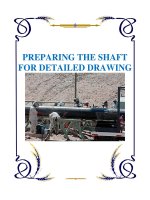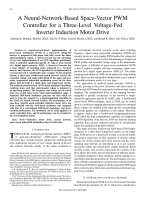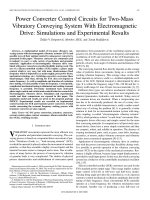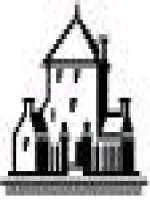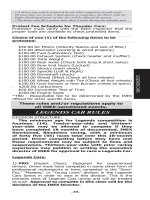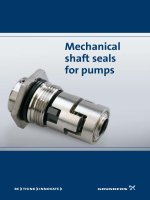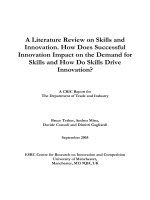Drive shaft for cars
Bạn đang xem bản rút gọn của tài liệu. Xem và tải ngay bản đầy đủ của tài liệu tại đây (2.58 MB, 55 trang )
start
Automotive Technology: Principles, Diagnosis, and Service, 3rd Edition
By James D. Halderman
©©2008
2009Pearson
PearsonEducation,
Education,Inc.
Inc.
Pearson
PearsonPrentice
PrenticeHall
Hall- -Upper
UpperSaddle
SaddleRiver,
River,NJ
NJ07458
07458
OBJECTIVES:
After studying Chapter 96, the reader should be
able to:
•
•
•
Prepare for ASE Suspension and Steering
(A4) certification test content area “C”
(Related Suspension and Steering Service).
Name driveshaft and U-joint parts, and
describe their function and operation.
Describe how CV joints work.
Continued
Automotive Technology: Principles, Diagnosis, and Service, 3rd Edition
By James D. Halderman
©©2008
2009Pearson
PearsonEducation,
Education,Inc.
Inc.
Pearson
PearsonPrentice
PrenticeHall
Hall- -Upper
UpperSaddle
SaddleRiver,
River,NJ
NJ07458
07458
OBJECTIVES:
After studying Chapter 96, the reader should be
able to:
•
•
Explain how the working angles of the Ujoints are determined.
List the various types of CV joints and their
applications.
Automotive Technology: Principles, Diagnosis, and Service, 3rd Edition
By James D. Halderman
©©2008
2009Pearson
PearsonEducation,
Education,Inc.
Inc.
Pearson
PearsonPrentice
PrenticeHall
Hall- -Upper
UpperSaddle
SaddleRiver,
River,NJ
NJ07458
07458
KEY TERMS:
cardan joints • center support bearing • CV joint boot •
CV joints
double-cardan joints • drive axle shaft • driveshaft
fixed joint
half shaft
plunge joint • propeller shaft
Rzeppa joint • spider
trunnions • universal joints
Automotive Technology: Principles, Diagnosis, and Service, 3rd Edition
By James D. Halderman
©©2008
2009Pearson
PearsonEducation,
Education,Inc.
Inc.
Pearson
PearsonPrentice
PrenticeHall
Hall- -Upper
UpperSaddle
SaddleRiver,
River,NJ
NJ07458
07458
A drive axle shaft transmits engine torque from the
transmission or transaxle (if front wheel drive) to the
rear axle assembly or drive wheels.
Driveshaft is the term used by the Society of
Automotive Engineers (SAE) to describe the shaft
between the transmission and the rear axle assembly
on a rear-wheel-drive vehicle.
The SAE term will be used throughout this textbook.
Automotive Technology: Principles, Diagnosis, and Service, 3rd Edition
By James D. Halderman
©©2008
2009Pearson
PearsonEducation,
Education,Inc.
Inc.
Pearson
PearsonPrentice
PrenticeHall
Hall- -Upper
UpperSaddle
SaddleRiver,
River,NJ
NJ07458
07458
A drive axle shaft transmits engine torque from the transmission or
transaxle (front wheel drive) to the rear axle assembly or
drive wheels.
Figure 96–1 Typical rear-wheel-drive power train
arrangement. The engine is mounted longitudinal
(lengthwise).
Continued
Automotive Technology: Principles, Diagnosis, and Service, 3rd Edition
By James D. Halderman
©©2008
2009Pearson
PearsonEducation,
Education,Inc.
Inc.
Pearson
PearsonPrentice
PrenticeHall
Hall- -Upper
UpperSaddle
SaddleRiver,
River,NJ
NJ07458
07458
Figure 96–2 Typical front-wheel-drive power train arrangement. The engine is usually mounted
transversely (sideways).
Continued
Automotive Technology: Principles, Diagnosis, and Service, 3rd Edition
By James D. Halderman
©©2008
2009Pearson
PearsonEducation,
Education,Inc.
Inc.
Pearson
PearsonPrentice
PrenticeHall
Hall- -Upper
UpperSaddle
SaddleRiver,
River,NJ
NJ07458
07458
Figure 96–3 Typical driveshaft (also called a
propeller shaft). The drivershaft transfers
engine power from the transmission to the
differential.
A typical driveshaft is a hollow steel tube.
A splined end yoke is welded onto one end
that slips over the splines of the output shaft
of the transmission. An end yoke is welded
onto the other end of the driveshaft. Some
driveshafts use a center support bearing.
Continued
Automotive Technology: Principles, Diagnosis, and Service, 3rd Edition
By James D. Halderman
©©2008
2009Pearson
PearsonEducation,
Education,Inc.
Inc.
Pearson
PearsonPrentice
PrenticeHall
Hall- -Upper
UpperSaddle
SaddleRiver,
River,NJ
NJ07458
07458
DRIVESHAFT DESIGN
Most driveshafts are constructed of hollow steel tubing. The forces
are transmitted through the surface of the driveshaft tubing. The
surface is in tension, and cracks can develop on the outside surface
of the driveshaft due to metal fatigue. Driveshaft tubing can bend
and, if dented, can collapse.
Figure 96–4 This driveshaft failed
because it had a slight dent
caused by a rock. When engine
torque was applied, the driveshaft
collapsed, twisted, and then broke.
Continued
Automotive Technology: Principles, Diagnosis, and Service, 3rd Edition
By James D. Halderman
©©2008
2009Pearson
PearsonEducation,
Education,Inc.
Inc.
Pearson
PearsonPrentice
PrenticeHall
Hall- -Upper
UpperSaddle
SaddleRiver,
River,NJ
NJ07458
07458
Most rear-wheel-drive cars and light trucks use a one- or two-piece driveshaft. A steel tube driveshaft has a
maximum length
of about 65 in. (165 cm). Beyond this length, a center support bearing, called a steady bearing or hanger
bearing, must be used.
Some vehicle manufacturers use aluminum driveshafts; these can be as long as 90 in. (230 cm) with no
problem. Many extended-cab pickup trucks and certain vans use aluminum driveshafts to eliminate the need
(and expense) of a center support bearing.
Composite-material driveshafts are also used in some vehicles. These carbon-fiber-plastic driveshafts are very
strong yet lightweight, and canbe made in extended lengths without the need for a center support bearing.
See Figure 96–5.
Continued
Automotive Technology: Principles, Diagnosis, and Service, 3rd Edition
By James D. Halderman
©©2008
2009Pearson
PearsonEducation,
Education,Inc.
Inc.
Pearson
PearsonPrentice
PrenticeHall
Hall- -Upper
UpperSaddle
SaddleRiver,
River,NJ
NJ07458
07458
Figure 96–5 A center support bearing is used on many vehicles with long driveshafts.
Automotive Technology: Principles, Diagnosis, and Service, 3rd Edition
By James D. Halderman
©©2008
2009Pearson
PearsonEducation,
Education,Inc.
Inc.
Pearson
PearsonPrentice
PrenticeHall
Hall- -Upper
UpperSaddle
SaddleRiver,
River,NJ
NJ07458
07458
To dampen driveshaft noise, it is common to line the inside of the
hollow driveshaft with cardboard. This helps eliminate the tinny
sound whenever shifting between drive and reverse in a vehicle
equipped with an automatic transmission.
Figure 96–6 Some driveshafts use rubber between an inner and outer housing to absorb
vibrations and shocks to the driveline.
Continued
Automotive Technology: Principles, Diagnosis, and Service, 3rd Edition
By James D. Halderman
©©2008
2009Pearson
PearsonEducation,
Education,Inc.
Inc.
Pearson
PearsonPrentice
PrenticeHall
Hall- -Upper
UpperSaddle
SaddleRiver,
River,NJ
NJ07458
07458
DRIVESHAFT BALANCE
All driveshafts are balanced. Generally, any driveshaft whose
rotational speed is greater than 1000 RPM must be balanced.
Driveshaft balance should be within 0.5% of the driveshaft
weight. (This is one reason why aluminum or composite
driveshafts can be longer because of their light weight.)
Driveshafts are often not available by make, model, and year of
the vehicle. There are too many variations at the factory, such as
transmission type, differential, or U-joint type.
To get a replacement driveshaft, it is usually necessary to know
the series of U-joints (type or style of U-joint) and the center-tocenter distance between the U-joints.
Continued
Automotive Technology: Principles, Diagnosis, and Service, 3rd Edition
By James D. Halderman
©©2008
2009Pearson
PearsonEducation,
Education,Inc.
Inc.
Pearson
PearsonPrentice
PrenticeHall
Hall- -Upper
UpperSaddle
SaddleRiver,
River,NJ
NJ07458
07458
U-JOINT DESIGN AND OPERATION
Universal joints (U-joints) are used at both ends of a driveshaft.
U-joints allow the wheels and the rear axle to move up and down,
remain flexible, and still transfer torque to the drive wheels.
A simple universal joint can be
made from two Y-shaped yokes
connected by a crossmember called
a cross or spider.
Figure 96–7 A simple universal joint (U-joint).
The four arms of the cross are
called trunnions. A similar design
is the common U-joint used with a
socket wrench set.
Continued
Automotive Technology: Principles, Diagnosis, and Service, 3rd Edition
By James D. Halderman
©©2008
2009Pearson
PearsonEducation,
Education,Inc.
Inc.
Pearson
PearsonPrentice
PrenticeHall
Hall- -Upper
UpperSaddle
SaddleRiver,
River,NJ
NJ07458
07458
Most U-joints are called cross-yoke joints or Cardan joints, named for a sixteenth-century
Italian mathematician who worked with objects that moved freely in any direction.
Torque from the engine is transferred through the U-joint. The engine drives the U-joint at
a constant speed, but the output speed of the U-joint changes because of the angle of the
joint. The speed changes twice per revolution.
See Figure 96–8.
The greater the angle, the greater the change in speed (velocity).
Continued
Automotive Technology: Principles, Diagnosis, and Service, 3rd Edition
By James D. Halderman
©©2008
2009Pearson
PearsonEducation,
Education,Inc.
Inc.
Pearson
PearsonPrentice
PrenticeHall
Hall- -Upper
UpperSaddle
SaddleRiver,
River,NJ
NJ07458
07458
Figure 96–8 How the speed difference on the output of a typical U-joint varies with the speed
and the angle of the U-joint. At the bottom of the chart, the input speed is a constant 1000 RPM,
While the output speed varies from 900 RPM to 1100 RPM when the angle difference in the joint
is only 10°. At the top part of the chart, the input speed is a constant 1000 RPM, yet the output
speed varies from 700 to 1200 RPM when the angle difference in the joint is changed to 30°.
Continued
Automotive Technology: Principles, Diagnosis, and Service, 3rd Edition
By James D. Halderman
©©2008
2009Pearson
PearsonEducation,
Education,Inc.
Inc.
Pearson
PearsonPrentice
PrenticeHall
Hall- -Upper
UpperSaddle
SaddleRiver,
River,NJ
NJ07458
07458
If one U-joint were used in a driveline, change in speed of the
driven side (output end) would generate vibrations in the driveline.
To help reduce vibration, another U-joint is used at the other end of
the driveshaft. If the angles of both joints are nearly equal, the
acceleration and deceleration of one joint is offset by the alternate
deceleration and acceleration of the second joint.
It is very important that both U-joints operate at about
the same angle to prevent excessive driveline vibration.
Figure 96–9 The joint angle
is the difference between
the angles of the joint.
(Courtesy of Dana
Corporation)
Automotive Technology: Principles, Diagnosis, and Service, 3rd Edition
By James D. Halderman
©©2008
2009Pearson
PearsonEducation,
Education,Inc.
Inc.
Pearson
PearsonPrentice
PrenticeHall
Hall- -Upper
UpperSaddle
SaddleRiver,
River,NJ
NJ07458
07458
Acceptable Working Angles Universal joints used in a typical driveshaft should have a working
angle of 1/2 to 3 degrees. The working angle is the angle between the driving and driven end
of the joint.
If the driveshaft is perfectly straight (0-degree working angle), then the needle bearings inside the
bearing cap are not revolving because there is no force (no difference in angles) to cause the rotation
of the needle bearings.
If the needle bearings do not rotate, they can exert a constant pressure in one place and damage the
bearing journal.
See Figure 96–10.
Continued
Automotive Technology: Principles, Diagnosis, and Service, 3rd Edition
By James D. Halderman
©©2008
2009Pearson
PearsonEducation,
Education,Inc.
Inc.
Pearson
PearsonPrentice
PrenticeHall
Hall- -Upper
UpperSaddle
SaddleRiver,
River,NJ
NJ07458
07458
If a two-piece driveshaft is used, one U-joint (usually the front)
runs at a small working angle of about 1/2 degree, just enough to
keep the needle bearings rotating. The other two U-joints (from the
center support bearing and rear U-joint at the differential) operate
at typical working angles of a single-piece driveshaft.
Figure 96–10 The angle of
this rear U-joint is
noticeable.
Continued
Automotive Technology: Principles, Diagnosis, and Service, 3rd Edition
By James D. Halderman
©©2008
2009Pearson
PearsonEducation,
Education,Inc.
Inc.
Pearson
PearsonPrentice
PrenticeHall
Hall- -Upper
UpperSaddle
SaddleRiver,
River,NJ
NJ07458
07458
If the U-joint working angles differ by more than 1/2 degree, a vibration is usually
produced that is torque sensitive. As the vehicle is first accelerated from a stop, engine
torque can create unequal driveshaft angles by causing the differential to rotate on its
suspension support arms.
This vibration is most noticeable when the vehicle is heavily loaded and being accelerated
at lower speeds. The vibration usually diminishes at higher speeds due to decrease in the
torque being transmitted.
If the driveshaft angles are excessive (over 3 degrees), a vibration is usually produced that
increases as the speed of the vehicle (and driveshaft) increases.
Continued
Automotive Technology: Principles, Diagnosis, and Service, 3rd Edition
By James D. Halderman
©©2008
2009Pearson
PearsonEducation,
Education,Inc.
Inc.
Pearson
PearsonPrentice
PrenticeHall
Hall- -Upper
UpperSaddle
SaddleRiver,
River,NJ
NJ07458
07458
